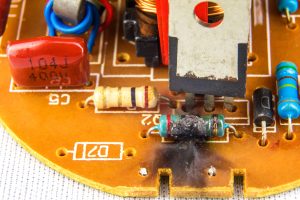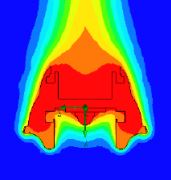LED component manufacturers have revolutionised the lighting industry, offering energy efficiency, durability, and versatility for various applications. However, LED overheating remains a significant concern for manufacturers and users alike. Overheating leads to reduced LED performance, decreased lifespan, and in some cases, even safety hazards.

High-power lighting-class LEDs run at impressively high temperatures. But there’s a limit to how much power LEDs can handle, and it is essential that adequate heatsinking is provided to prevent overheating.
LED overheating has several causes, ranging from design flaws to environmental factors. One of the most common causes is poor LED thermal management, where the heat generated by the LED is not dissipated efficiently. This can happen due to inadequate heat sinks, insufficient ventilation, or using the wrong materials.
Another potential cause is electrical current issues, such as overdriving the LED, which can generate excess heat. Also, a well-designed LED luminaire can be overheated by installing in an environment for which it was not designed.
Ambient temperature plays a role in LED overheating, and high temperatures can cause LED components to fail. Other environmental factors, such as humidity and dust accumulation, can also contribute to overheating by reducing the effectiveness of heat sinks and ventilation.
Poor design and manufacturing processes can also lead to overheating, as defective components or faulty circuit designs can create excess heat or reduce the LED's ability to dissipate heat effectively. Overall, it is essential to identify the root cause of LED overheating, to implement the appropriate solutions and prevent future issues.

LED overheating can cause significant damage to both the LED and surrounding luminaire and create detrimental results.
The most significant impact overheating has on LEDs is to reduce their lifespan dramatically. Excessive heat causes thermal stress on the LED's components, such as the solder joints and circuit boards, leading to early failure. This results in costly repairs and replacements for end users.
Overheating may eventually cause damage to the surrounding luminaire, and excess heat can cause additional damage, such as warping and even cracking of the housing and other components. In addition, overheating can sometimes lead to fire hazards, particularly if the luminaire's electrical components are damaged or compromised.
Overheating can cause a significant change in LED colours, particularly for white LEDs. White LEDs are typically created using blue LED chips and a phosphor coating that converts blue light into white light. When overheating, the phosphor layer degrades, leading to a shift in the colour temperature of the LED.
This shift in colour temperature will have significant implications for the aesthetics of lighting applications, particularly those where consistent colour temperature is critical, such as in retail, museum settings or hospitality LED lighting. In some cases, overheating causes a significant change in LED colour, leading to a shift from white light to a different colour altogether. This is particularly damaging for applications where colour accuracy is essential, such as in photography, art installations or road safety lighting.
Lumen output (or lumen maintenance) is a term used to describe the gradual reduction of a light source's brightness over time. LED overheating significantly impacts lumen maintenance, gradually reducing the LED's overall brightness and efficiency.
When an LED overheats, it causes thermal stress on the LED's components, including the phosphor layer, which is responsible for converting blue LED light into white light. Over time, the phosphor layer breaks down due to high temperatures, significantly reducing lumen output.
Overheating may cause custom LED drivers and other electrical components to degrade, reducing the LED's overall efficiency and light output. This reduction in lumen output has significant negative implications for lighting applications, particularly in commercial LED lighting systems or industrial settings where consistent lighting levels are critical, resulting in increased maintenance
Here’s a list of general advice that will ensure the longevity of your LEDs:

At Forge, we have implemented many design strategies to prevent LED overheating, including well-designed LED thermal management.
Our expert engineers use advanced computer modelling and simulation tools to optimise the LED lighting systems they create for efficient heat dissipation, ensuring that heat generated by the LED is quickly and effectively removed.
We use the highest-quality materials for our heatsinks, such as aluminium, which has excellent thermal conductivity. This allows for effective heat transfer from the LED to the surrounding environment. By effectively managing heat through a great LED heatsink design, the LED will operate safely and efficiently, maintaining optimal performance and longevity. Contact us to discuss your application and discover how we ensure it resists overheating.


